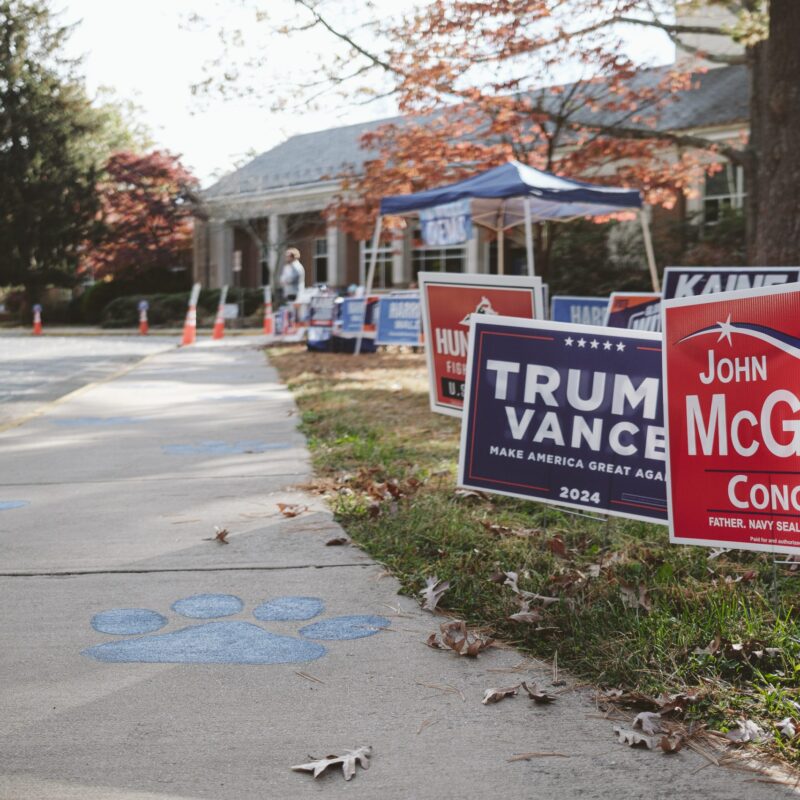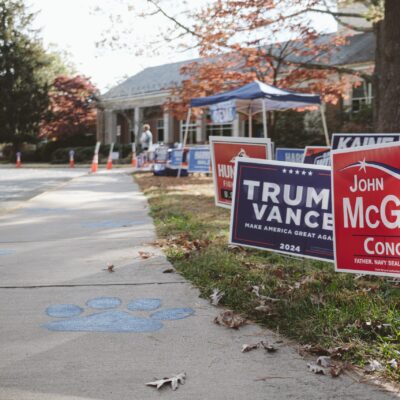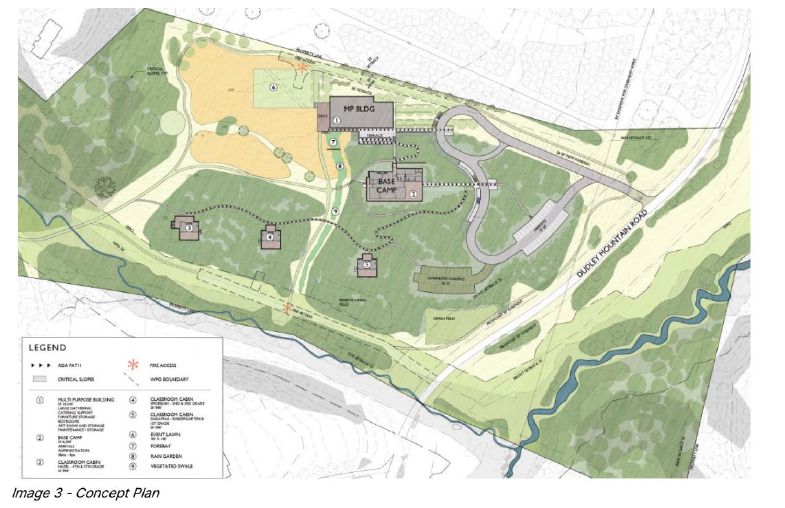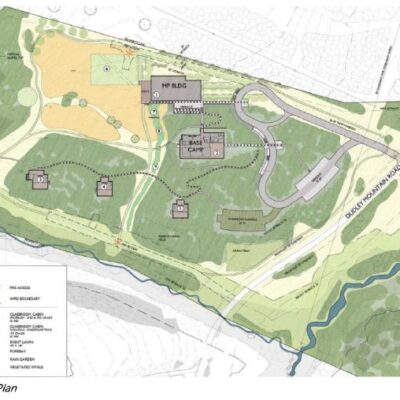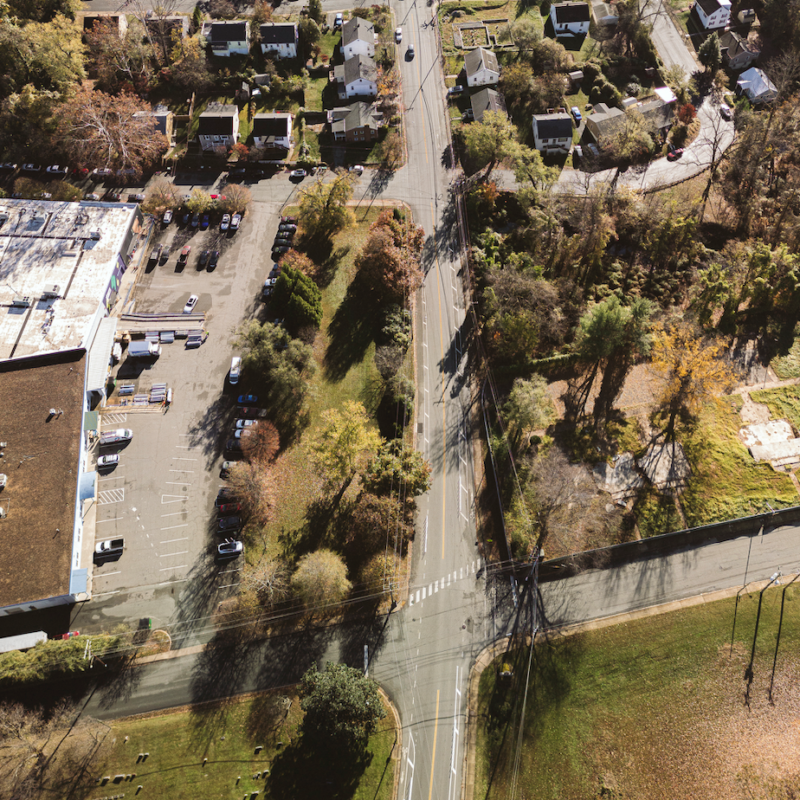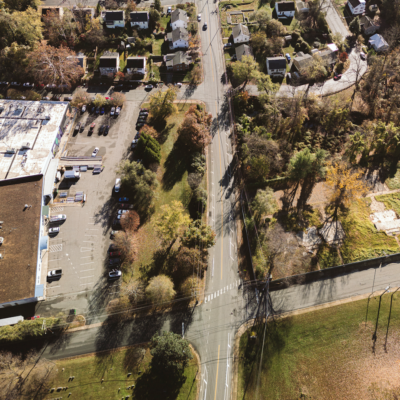By some measures, UVA is pretty affordable. The elite state school that benchmarks itself against privates like Cornell, Stanford and Duke still offers a price tag that’s truer to its public school mandate: about $17,700 a year for in-state students and more than $35,600 for out-of-staters.
A visit to the Corner on an average afternoon lends the impression that many students have no trouble affording it.
At Starbucks, girls in premium denim line up for $4 lattes. They carry $80 backpacks from The North Face or more stylish shoulder totes from Vineyard Vines, Coach, even Louis Vuitton or Gucci.
A group of sharp-dressed boys sitting on an Elliewood Avenue stoop, petting a shiny, golden Labrador are overheard: “Yes, but if you buy the glass, you get the wine tasting for free!”
| UVA Office of Admission student profile |
RAZR phones flip open and shut, grey New Balance sneakers pad the sidewalk, Barbour jackets are buttoned against the brisk wind, Burberry scarves peek from behind collars, Ray-Ban sunglasses filter out the glinting sunlight. BMWs and Range Rovers almost collide along the narrow, stone-walled drive.
In 2004, 58 percent of UVA students came from families that made $100,000 per year or more. One in five came from families over the $200,000 mark, even though only 2.4 percent of American families have that kind of wealth.
 |
This kind of inequality characterizes many American universities, not just UVA.
As tuition costs rise, fewer low- and middle-income families think they can afford college, so their children aren’t even applying. A federal panel estimates that between 1.4 and 2.4 million qualified students from low- and middle-income families won’t earn bachelor’s degrees in the next decade due to financial constraints. [The relevant report from the US Department of Education can be downloaded here.]
 |
[The above graph is pulled from a report by the Pell Institue for the Study of Opportunity in Higher Education available for download here.]
Federal Pell grants, the standard measuring stick for students’ financial need, are awarded to kids with family incomes below about $40,000. But they’re declining in buying power, and fewer of their recipients enroll at the most elite institutions.
Hoping to turn the trends around for poorer students, colleges have begun to think about socioeconomic diversity on campus.
“This country is developing some very rich people, and some very poor people,” UVA Admissions Dean John A. Blackburn says. “Higher ed has to recognize that and do something about it.”
Taking a cue from schools like Harvard, Princeton and the University of North Carolina at Chapel Hill, UVA President John T. Casteen, III resolved in 2004 that UVA would do its part. Through a relatively new program, AccessUVA, it’s offering $20 million a year or more in grant funds and is promising to meet demonstrated financial need for all students. [For more detail, see sidebar.]
“That’s a very strong commitment,” says Yvonne Hubbard, UVA’s director of student financial services. “Most publics can’t meet need.”
The program’s marketing campaign is focused and direct. Sean Patrick Thomas, film actor and UVA alum, beams from AccessUVA’s website, his posture inviting. “Got the brains but not the bucks?” the site reads. “The door is open.”
So far, few students have walked through. Since 2004, UVA has enrolled 527 students on all-grant packages. In 2006, the University provided $33.5 million in grant funds through AccessUVA. But, currently only 5.5 percent of UVA’s student body is considered “low-income.”
| UVA by the Numbers
In-state cost (including tuition, room and board, travel and expenses): $17,725 Out-of-state cost (not including travel): $35,605 Percentage of students on Pell grants: 7.9 Percentage who are “low-income”: 5.5 Percentage who apply for financial aid: 25 Percentage of undergraduates who apply for financial aid: 45 Funds given in need-based aid 2006-07: $33.5 million Funds given in merit-based aid 2006-07: $12.9 million Percent of entering students in top decile of high school class: 88 Average SAT score of freshman entering 2006: 1325 (out of 1600) Percentage of students from public high schools, class entering 2006: 74 Percentage from private high schools, class entering 2006: 26 |
That makes “Access kids” one of the smallest slices of the UVA population. So, what is the college experience like for poorer kids once they get to UVA? We checked in with a few students to see how they came to be in Charlottesville, and what life on serious financial aid is like at one of the nation’s most elite public schools.
“A feeling of inferiority”
I catch up with Ashley Robins at Starbucks on the Corner. It’s loud and bustling with mostly student types. We sit in a drafty corner on the second floor by a big window overlooking a grassy expanse, east of the Rotunda. A group of girls planning a sorority event twitter from the next table.
Robins is pretty and extremely pulled-together, with wavy hair and an easy laugh. She wears a dark coat and carries a large tote bag, the kind that many students rely on when they’re on-the-go all day. She is lighthearted and chatty, but frank.
Robins grew up in a Chicago suburb. She attended Trinity High School, a private, all-girls Catholic school, and was part of the federal Upward Bound program, which assists low-income families or families with no precedent of college attendance. Living close to the city, Robins and her four older sisters were afforded lots of cultural opportunities. “We were always busy,” she recalls, with piano lessons, dance lessons and sports.
In high school, Robins was in an International Baccalaureate program, in the top 10 percent of her class. She acted in the drama program, participated in dance and soccer and was president of a group called SADD, Students Against Disruptive Decisions.
UVA was not her dream school. Robins is an urbanite at heart who wanted to attend New York University, which is private, pricey and located in one of the most expensive cities on the planet. Her mother prodded her to put a few other colleges on her list.
Robins knew little about UVA aside from the five-year master’s in education program. She had never visited the campus. “My parents didn’t go to college, so I was kind of going into it blindly,” she says.
Still, she couldn’t pass up the financial aid package. At NYU, with financial aid, she still would have had to pay about $20,000 over four years. UVA offered her an education for under $6,000.
So, she’s made the most of it. At UVA she has joined a co-ed honor fraternity. She also sings in Black Voices gospel choir and participates in dance ministry. To help offset college costs, she’s worked at Newcomb Hall, first at the information desk and now as a manager.
She majored in religious studies, and plans to head back to the Midwest to graduate school studies in marriage and family therapy. She wants to become a marriage counselor.
Robins admits, “The students that go to UVA can be a bit intimidating. …They shop at completely different stores than you shop in because of economic difference. I’ll shop at Marshalls and T.J.Maxx, and they’re going to Banana Republic and J.Crew.”
Over time, she’s learned, “I am not my economic situation. We’re all people, and all students here at the University. And really, that’s not your money, it’s your parents’ money, so it kind of makes me feel better.”
“I think the environment for someone coming from a low economic status could be challenging,” Robins says. Her first impression, she says, was “a feeling of inferiority.”
.
 Yvonne Hubbard, UVA Student Financial Services director, is the money lady. Her office doles out the more than $20 million per year UVA has pledged for new financial aid programs. |
“To me, college equaled debt"
Zechariah Jones recommends meeting in the ballroom on the top floor of Newcomb Hall, the student activities center. The ceilings in that room soar; elaborate moldings cap off walls with traditional paint colors, framed portraits and arched windows. A grand piano is at one corner and four clusters with armchairs, small couches and woven rugs are at each end of the echoing expanse.
The 6’2" Jones looks as if he barely fits on the couch he’s chosen—I would have easily believed him if he said he played on the football team.
Jones is incredibly quick, but a good listener, taking it all in before he begins crafting his responses. He doesn’t speak in flashy, quotable sentences, he just tells it like it is.
He grew up just over the mountain in Staunton. The son of a homemaker and a Virginia Transportation worker, Jones is one of 13 siblings.
In high school, he graduated with a 4.0 and was sixth in a class of about 126 at Robert E. Lee High, where he excelled at math. Despite his performance, Jones had no plans to attend any college. His mother has a four-year degree in child psychology (“which she gets good use out of with 13 children”), and his father attended college for two years. An older sister went to Virginia Commonwealth University and finished her bachelor’s degree at Bridgewater College.
Jones saw his sister fall into debt. “To me, college equaled debt, and I didn’t want any part of that,” he says.
 Ashley Robins got her first taste of Southern culture when she came to UVA. She’s gotten used to the moneyed atmosphere, but says "the environment for someone with a low-income status could be challenging." |
So, his plan was to get a job in Staunton and live with his parents until he could afford to get an apartment. Jones’ mother pushed him to apply to UVA.
“They have a pretty good financial aid package,” Jones says, smiling at the understatement. Jones is on an all-grant package through AccessUVA. For students whose families earn 200 percent of the federal poverty level (about $38,000 for a family of four) or less, grant-in-aid funds replace student loans. He’ll owe only $3,000 he borrowed to attend one summer school session.
For Jones, being at UVA is about practicality. He still travels home frequently, helping his dad with window-washing jobs in downtown Staunton for extra cash. At UVA, the sophomore has played some intramural sports, but admits he hasn’t found his niche group of friends or activities. “My group of friends is still at home,” he says. “When you have 12 brothers and sisters, those are your friends.”
Jones isn’t sure what he’ll do with his studio art major—he’s interested in graphic design, and might still tack on a math minor. Going forward, he says, he’ll get a job and eventually think about graduate school.
Jones doesn’t have much to say about his status as a financial aid kid. His first impression of UVA was: “big.” He’s been amazed at the diversity of people he never would have met in Staunton, and the fact that lots of the kids around him have money doesn’t seem to bother him. He’s doing his own thing and earning a degree. Without his financial aid, he knows UVA would have been impossible.
“A lot of stress associated with finances”
Starbucks is even more crowded and chaotic when I meet Katie Mills. A class change seems to have populated the small coffee shop to capacity, but we manage to snag the drafty corner table, though most of the other spots upstairs are taken. Kids are huddled over textbooks, typing on laptops or chatting in groups. It looks like the perfect collegiate study environment, though it’s hard to imagine how anyone gets any work done.
In her senior year of high school, Mills (not her real name) knew she wanted to be a typical UVA student. “I knew when I first came here that I loved it. I loved the people, I loved the atmosphere,” she says.
A pretty young woman with long, brown hair and blue eyes, Mills remembers high school fondly.
She graduated third in a class of 200 at her high school in Yorktown, was a National Honor Society member and a varsity athlete who participated in clubs, excelled at English and biology and assistant-taught algebra students in middle school. Of her near-salutatorian status she says, “I didn’t want to talk [at graduation].”
Other schools recruited her based on her SAT scores. “I could have gotten a full ride to other institutions that aren’t as prestigious.” But, she says, “I was dead-set on UVA.”
But, in other ways, Mills didn’t quite fit the UVA mold. She grew up clipping coupons, always aware of her family’s financial constraints. “There was a lot of stress associated with finances.” After she applied to UVA, though, things got much worse.
(C-VILLE agreed to use a pseudonym because of the sensitivity of her story.)
On Thanksgiving morning of her senior year, Mills’ father crashed his car on their street, setting it on fire. He “had alcohol, drug and prescription drug problems,” and was “emotionally and physically violent,” Mills says softly, with a controlled, almost deadpan delivery.
After the bender, her dad left for a four-month business trip. He returned in April, about the time Mills got her UVA acceptance letter.
“The day he came back…he got really physical with my mom, my sister and I. We had to call the police and got him physically removed from our house with protective orders.
“His pockets were filled with my high school ring, my mother’s jewelry, things like that. The police assumed that he was attempting to pawn it to either pay back debts he owed to drug dealers or to pay for more drugs,” she says.
Mills’ mother was only working part time. Mills and her two younger sisters and brother had relied on their father’s income and insurance benefits.
Mills and her mother got jobs to pay the bills. But they were in a predicament when it came to paying for UVA.
When she called the financial aid office, they told Mills, “‘We’re going to find a way to make it work.’”
Now a UVA senior, Mills will complete a bachelor’s degree in English and a master’s degree in education in four and a half years—she’s always wanted to become a teacher. Grants are covering most of her tuition and room and board. She’ll graduate with about $10,000 in debt, which she knows will be tough to pay back. Her biggest expense, she says, is paying for health insurance.
In a black The North Face fleece jacket that is UVA’s uniform, Mills fits in on Grounds. She’s had a job at the Aquatics and Fitness Center since her first year, she’s served on resident staff and was vice president of her sorority.
Mills has found ways around her status as a financial aid student. She wanted to study abroad, but it’s expensive, so she took a job working as a counselor in Europe.
She admits, “there still are moments when people’s attitudes toward money just blow my mind, how casual some people are. …It surprises me and makes me laugh a little.”
Still, she’s not jealous of others’ wealth. “It would be really hard for me to think of somebody I would trade places with financially.”
Before we leave Starbucks, she orders the drink I promised her—a caramel apple cider—and I remember her observation about wealthy students: “It’s a lot harder to appreciate the little things in life when they come so easily.”
“We want these students to soar”
These three students are just the type of satisfied customers administrators hope AccessUVA will create: students with great high school credentials, getting everything they can out of a college experience made affordable through financial aid.
But low-income students still face significant obstacles, even if they voice few complaints.
Kids from wealthy families can afford things like pricey study abroad programs (UVA’s new Semester at Sea program costs more than $17,000) and unpaid summer internships.

Zechariah Jones never thought of going to college. He’s at the University on an all-grant package through AccessUVA. |
Internships are no longer the accoutrements of a college life well lived, but are “universally perceived as an essential stepping stone to career success,” Mark Oldman, author of The Internship Bible, told The New York Times in a 2004 piece about the unfairness of unpaid internships.
Schools like Amherst College in Massachusetts buy suits for poorer students with corporate internships or job interviews, and many schools offer internship aid. At UVA, University Career Services offers some scholarships to offset the cost of a summer of unpaid work, at most around $2,500.
But for some students, not working during the summer would be impossible. Even on a “no-debt” financial aid program, Dean Blackburn says, “many of the AccessUVA students are taking other loans.” His theory? Some send money home to their families.
“I think there are lots of issues,” Blackburn says. “Social and cultural adjustment is critical. Students may think they’d be more comfortable on another campus.”
There is, Blackburn says, “the Charlotte Simmons profile.” “Young people come here on financial aid, room with somebody who…drives the big SUV, goes out to eat on the Corner four times a week. That’s a tough, tough situation [for someone who] can’t afford even a Bodo’s bagel, who has to go to the dining hall.”
Hubbard, UVA Student Financial Services director, hears the worries in her office, too. “Will I fit in?” prospective students ask. “We believe that they will,” she says.
UVA has done its best to make sure students do fit in. Designed to afford financial aid students the full “UVA experience,” AccessUVA doesn’t require work-study, so students can spend all their time in school activities if they want.
“We want these students to soar, to do everything and anything. …I expect that they’ll be Phi Beta Kappa, student body president, Honor Committee, Lawnies,” Blackburn says, rattling off a partial list of UVA’s most prestigious extracurriculars.
It’s too early to tell if those hopes will come true, since the first class of Access students are only in their third year.
Hubbard’s office will soon release a study, to include stats about student retention rate and academic performance. According to Blackburn, “The initial reports are good.”
Institution-wide, administrators want to get Pell grant recipients at UVA back up to 11 percent—UVA hasn’t had that many Pell students since the 1990s.
Only about 25 percent of UVA students apply for financial aid. The administration would like to see that number rise to about one third of students receiving some type of aid.
David W. Breneman, dean of UVA’s Curry School of Education, says of AccessUVA: “What’s not to like about it? …They’re looking to see this not just affect a small group of people who are very low-income,” but help level the entire playing field.
But if national stats are an indicator, UVA administrators may be disappointed. Universities with similar programs have had “modest” returns in increasing socioeconomic diversity, according to a special report last May in the Chronicle of Higher Education.
Princeton, which for a decade has had financial aid programs aimed at the issue, has seen Pell grant recipients rise only slightly, with numbers holding steady at 7.5 percent of the student body for about a decade.
This may reflect that such programs can do little to stack up against inequality on campus. Other researchers have pointed out that many factors bar the way for low-income students, starting way before college-application time. Whatever the cause, the fact remains that few low-income students squeak their way into top schools.
For now, administrators say they are trying to enroll as many low-income students as possible. [See sidebar on how low-income students are getting more attention in the admissions office.] But, given the generous aid UVA awards to financial aid recipients, is it fair to wonder how large the commitment to socioeconomic diversity can possibly become?
Peter Sacks, a higher education author writing for the Chronicle of Higher Education, says, “Virtually all of the highly publicized efforts by top institutions—Harvard, the University of Virginia, the University of North Carolina at Chapel Hill, and others ensuring that needy students graduate debt-free—are financially feasible because so few lower-income students are admitted.”
